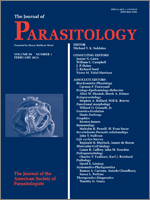The nematodes Eustrongylides spp. collected from different fish species in China were examined for their intra- and interspecific evolutionary variations using the molecular markers mitochondrial cytochrome oxidase c subunit 1 (COI) gene and internal transcribed spacer (ITS) rDNA regions. The phylogenetic analysis indicated that Eustrongylides species are divided into 3 well-supported clades. The ITS divergence between the clades suggested that clades 2 and 3 might represent the same species, whereas clade 1 represent another cryptic species. The host specificity of these nematodes was analyzed according to prevalence data, host range, and phylogenetic information. Clade 1 was found in 4 fish species, i.e., Odontobutis obscurus, Silurus asotus, Culter mongolicus, and Acanthogobius flavimanus, but was predominant in the 2 perciform species, O. obscurus and A. flavimanus. Clade 2 was found in 3 fish species, Monopterus albus, Channa argus, and Channa asiatica, but was predominant in M. albus, reported to feed primarily on oligochaetes, the first intermediate host of Eustrongylides sp. Clade 3 was found in 9 species, but its low prevalence suggests accidental infection in all species. Although the larval nematode presented low host specificity, it exhibited some host preference.
How to translate text using browser tools
1 February 2013
Molecular Phylogeny and Host Specificity of the Larval Eustrongylides (Nematoda: Dioctophmidae) From Freshwater Fish in China
Fan Xiong,
Wen X. Li,
Shan G. Wu,
Hong Zou,
Gui T. Wang
ACCESS THE FULL ARTICLE

Journal of Parasitology
Vol. 99 • No. 1
February 2013
Vol. 99 • No. 1
February 2013




